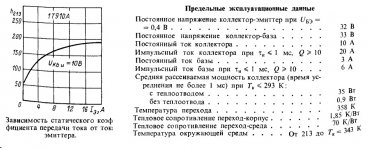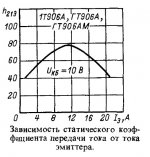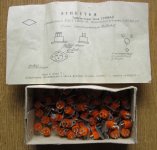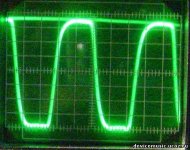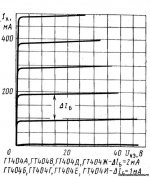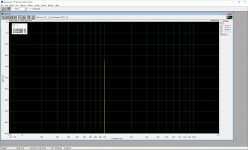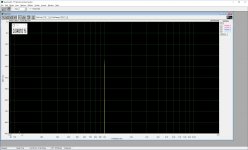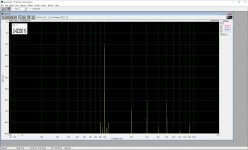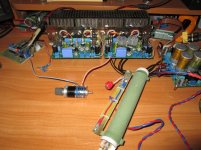The reason for great curiosity in germanium is the growth of the transmission coefficient with increasing current.
In the working positions of the current, of all cascades.
FWIW: ALL transistors do this, for some range of current.
The hFE gets to a maximum at some current.
At lower current, hFE drops due to recombination, leakage, and other mechanisms.
At higher current, hFE falls because the semiconductor crystal gets "crowded" (high-level injection).
"Where" this happens, relative to "normal working" currents, varies between different devices. Some semi-old devices like original 2N3055 were rated to 15A but hFE was falling fast above 4A, and also below 0.1A. Modern "2N3055" have flatter hFE curves. Germanium were all different.
...Germanium were all different.
It is so. They were different.
For example, germanium, high frequency GT906AM.
h21e increases to 12 A.
In general, germanium is much less greedy for current. Much closer to the conductors. Unlike silicon "stones".
Also, they are the easiest to open. By voltage. From all devices.
Switching-distortions are completely insignificant.
"Performance" is the aggregate indicator. Team of many positions
Thanks!
Attachments
Last edited:
On looking at this i can see that there is no effective global ac feedback as both sides seem to decoupled to gnd
Can you explain to me what is happening and what defines the gain of the amplifier i thinks it the ratio of the resistors in the emitters and the effective collector load of the predivers
Trev
Can you explain to me what is happening and what defines the gain of the amplifier i thinks it the ratio of the resistors in the emitters and the effective collector load of the predivers
Trev
Last edited:
This has the great advantage. Absence a global feedback for the variable voltage. Only 100% for constant voltage
Very stable parameters with germanium transistors.
Very stable parameters with germanium transistors.
Svjatoslav, many thanks for posting this. It is certainly not trivial to collect the full set of Ge transistors and diodes but i am sure it is worth it.
Do you set R11/R13 in the D3 circuit for minimum second harmonic?
Do you set R11/R13 in the D3 circuit for minimum second harmonic?
Exactly. A mean of obtain a DC stable amp but OL in audio frequencies. Very elegant!On looking at this i can see that there is no effective global ac feedback as both sides seem to decoupled to gnd
Can you explain to me what is happening and what defines the gain of the amplifier i thinks it the ratio of the resistors in the emitters and the effective collector load of the predivers
Trev
Although is rare to find a BJT with only rising beta well into the "complete die destruction", at least very above the Pc(max) like these 1T910 (rise to "infinity").FWIW: ALL transistors do this, for some range of current.
The hFE gets to a maximum at some current.
At lower current, hFE drops due to recombination, leakage, and other mechanisms.
At higher current, hFE falls because the semiconductor crystal gets "crowded" (high-level injection).
"Where" this happens, relative to "normal working" currents, varies between different devices. Some semi-old devices like original 2N3055 were rated to 15A but hFE was falling fast above 4A, and also below 0.1A. Modern "2N3055" have flatter hFE curves. Germanium were all different.
And good to see a 30MHz fT Ge power device 🙂 fun to play with.
By the way I suppose that it have heavy B-E junction doping and this kills the hFE in low current regime (for a hFE meter standpoint), more or less like SHF devices. Low impedance drive overcomes part of this (the leakage part). In fact I've tested them. Normally the hFE curves upward at low current with normal alloy Ge due to B-C leakage being dominant, until it finally starts to drop.
Soon I will use these 1T910 for making a series of 3 amplifiers experiences: one like the "el-cheapo" with SE input and SE "VAS", both cascoded, with a quasi-complementar output stage***, a open-loop trafo coupled amplifier à la Susan Parker, and a third like the first published in this thread. Experience is everything.
***I've made a lot of these amps and become curious to try with those devices.
Speaking about these plastic cased Ge (I've never seen before power Ge with partial plastic case), I liked very much the 1T905. Very high Early voltage for a Ge device, and the collector curves don't start to prematurely bends vertically after some power level like most Ge devices (this Ge behaviour I suppose to be related to its very low bandgap). Good for higher voltage Ge projects.
At least far cheaper than SIT or some triodes 🙂Svjatoslav, many thanks for posting this. It is certainly not trivial to collect the full set of Ge transistors and diodes but i am sure it is worth it.
Do you set R11/R13 in the D3 circuit for minimum second harmonic?
At least far cheaper than SIT or some triodes 🙂
what is the whole point.
Where did you get the large germanium transistors from as i cannot even find them on the net
Trev
Trev
Where did you get the large germanium transistors from as i cannot even find them on the net
Trev
You can find germanium transistors in the post-Soviet space.
Ask in Svjatoslav.😉
At ГТ320В (VT1,VT3) ГТ321Е (VT12,VT13), ГТ311И (VT5,VT7), 1Т321 (VT8,VT9), ГТ806 (VT10,VT11) Cirklotron D3, the bandwidth of -3 dB reached 1 MHz.
Meander of this variant, the frequency is 400 kHz.
Meander of this variant, the frequency is 400 kHz.
Attachments
Last edited:
Do you set R11/R13 in the D3 circuit for minimum second harmonic?
So. From my experience. The best work of the output cascade when the driver does not turn off. As the first one.
Or turning off very smoothly.
In attachment output characteristic GT404.
Attachments
Last edited:
Hi Svjatoslav,
how did you choose the value of the 200ohm output resistor ?
Thanks
Best regards
Seb
how did you choose the value of the 200ohm output resistor ?
Thanks
Best regards
Seb
Hi Seb,
R16, R17 were selected 200 ohms, so that the "empty" of the power loss was no more than several percent.
Best regards,
R16, R17 were selected 200 ohms, so that the "empty" of the power loss was no more than several percent.
Best regards,
- Home
- Amplifiers
- Solid State
- The Germanium-only circlotrons. Powerful, wideband.
